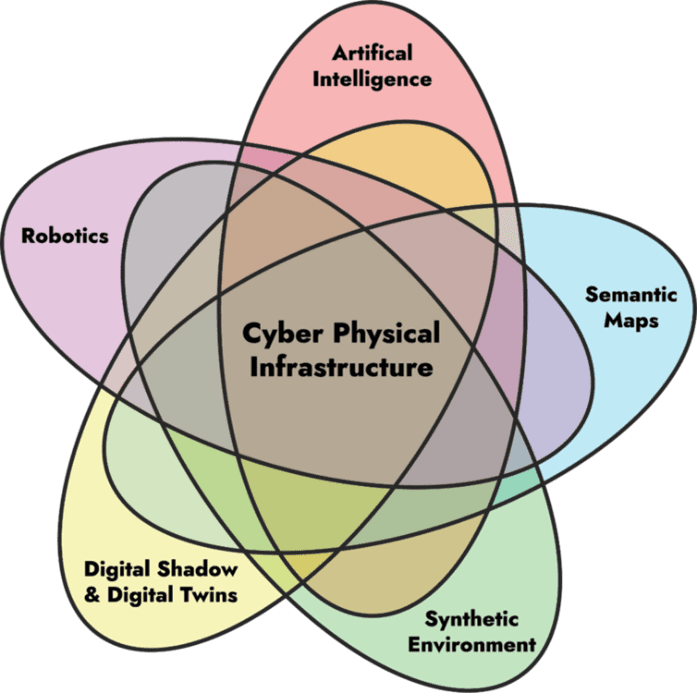Cyber-physical infrastructure aims to build on the UK’s strengths in technologies such as AI, digital twins and robotics to help create a more digital built environment and address key challenges such as tackling climate change and supporting sustainable growth. Dan Rossiter FCIAT of the Chartered Institute of Architectural Technologists takes a look
Back in 2022, the Department for Science, Innovation & Technology (DSIT), alongside the Department for Business & Trade (DBT), published a consultation on the government’s vision for Enabling Cyber-Physical Infrastructure.
A new term for many, cyber-physical infrastructure encapsulates concepts that connect the physical and digital domain; such as digital twins, internet of things, artificial intelligence and robotics.
Following a wealth of input, a Consultation Response Document was published outlining several key enablers to realise a society empowered by cyber-physical infrastructure, these being:
- Security and resilience: In particular how to overcome risk aversion and enable trust as part of data-driven decision making.
- Interoperability: In the wider sense, including interoperability of expectations and ethics.
- Recognised value proposition: Considering that a significant proportion of potential value lies in interconnection between datasets.
- Frameworks, guidance and standardisation: Fundamental enablers and catalysts for adoption.
- Skills: Ensuring society has the capability to establish, maintain and utilise such infrastructure.
The report also helpfully includes case studies that cut across key sectors such as energy, transport and the built environment. Among these case studies is work undertaken by the various Catapults, this work is also summarised by Simon Hart on the UKRI website.
What are the next steps?
In further support of realising cyber-physical infrastructure, Innovate UK also commissioned Responsive Infrastructure (The Fenby-Taylor Review). Henry, the author, has written about this report in detail. However, I thought it was worth highlighting several of its recommendations below, including:
- Increasing the visibility and viability of innovators.
- Addressing the skills gap.
- More tailored access to relevant research.
- Creating the opportunity to develop and test ideas within safe environments.
Finally, several Catapults have joined forces to explore how to best establish a Cyber-Physical System innovation ecosystem.
How can I engage?
Clearly there are a plethora of activities underway. So, what are some of the best ways to engage with this work?
National cyber-physical infrastructure
If you are interested in the work being undertaken by the Catapults to realise an innovation ecosystem, it is probably best to read Responsive Infrastructure (The Fenby-Taylor Review) and join the Digital Twin Hub. Several updates relating to NCPI have already appeared on the hub, which are summarised here.
Digital twins
Again, an ideal place to engage would be the Digital Twin Hub. If you are interested in the National Digital Twin programme specifically, they have recently created their own NDTp gov.uk site, which is currently populated with case studies.
Alternatively, if you are of a more disruptive mindset, you may enjoy engaging with the Digital Twin Fan Club and their Podcast series.
Finally, keep an eye out on the BSI website for the upcoming publication of BS ISO 30172 (digital twin use case) and BS ISO 30173 (digital twin concepts and terminology).

Information management and BIM
A foundational concept, information management and BIM continues to gain momentum both nationally and globally. One of the best ways to engage with the topic is through nima, as well as the UK BIM Framework website.
Artificial intelligence
If you are interested in standards (who isn’t?), then Alan Turing’s AI Standards Hub, is an ideal forum for you to engage with, as well as our National Standards Committee for Artificial Intelligence, ART/1.
Alternatively, if you are an innovator, in particular a small business, you may be interested in the Innovate UK BridgeAI programme, which offers funding and support to help innovators assess and implement AI.
While digital has been gaining momentum since the advent of computers, it had been doing so in a disjointed manner. The introduction of cyber-physical infrastructure has, helpfully, begun to bring these concepts under a single holistic framework. I am hopeful that this will not only catalyse our journey to a more digital built environment but also reduce frictions as we explore innovations beyond BIM.
Dan Rossiter FCIAT
Vice-president, technical
Chartered Institute of Architectural Technologists
Tel: +44 (0)20 7278 2206
www.architecturaltechnology.com














